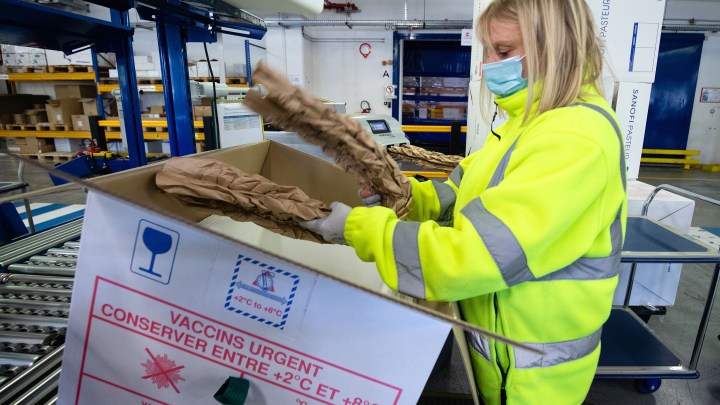
Vaccine delivery across the country faces complex supply chain challenges
Vaccine delivery across the country faces complex supply chain challenges

The nation’s first COVID-19 vaccine stands on the verge of approval, yet the complex distribution of the product — and the risk along the way — is keeping some logistics and public health professionals up at night.
The stakes could not be higher. This vaccine represents what one freight industry executive has termed “the biggest product launch in history.” Within 24 hours of emergency authorization from the Food and Drug Administration, the vaccine maker Pfizer plans to move the product to patients nationwide.
It’s a product that has to be kept ultracold during delivery, at roughly the average temperature of Mars, complicating an already challenging logistical project.
At the front end of the chain, the good news is that vaccines are being manufactured by several companies at multiple locations.
“You have a portfolio of suppliers and vaccines,” Anna Nagurney, operations management scholar at the University of Massachusetts Amherst, said. “Because if something happens with one, then you have a backup plan. And if you look at some of these vaccine manufacturers, they have multiple production sites, which is also really, really good.”
But what happens after production?
“Very little is being talked about when it came to distribution,” Nagurney said. “That’s something that is just now being addressed publicly.
The likely first vaccine from Pfizer must be kept around minus 90 degrees Fahrenheit, so vials will leave the factories in special boxes cooled with dry ice and equipped with GPS sensors for tracking.
Logistics giants like UPS and FedEx will pick up the specialty boxes, which in many cases will be loaded onto commercial jets. But when the medicine arrives at local sites, it will often get stored in standard refrigerators. That’s the best many clinics have.
At that point, the Pfizer vaccine can last just five days.
“That’s not typical. That is unusual,” said Claire Hannan, executive director of the Association of Immunization Managers, which represents state and local health agencies. “I think it’s especially challenging when you’re working at a hospital and you can’t vaccinate everybody in one day.”
Supply chain professionals call this the Last Mile problem: getting vaccine from a regional hub into the arms — literally — of patients.
One issue: Each Pfizer package holds nearly a thousand doses, more than a typical hospital can administer in just a few days.
“So states are looking to spread those doses across multiple hospitals,” Hannan said, “or store at a state freezer facility and spread it out across [a] larger number of providers.”
Many patients will travel to receive shots, but not frail nursing home residents, who should be among the first to get vaccinated, according to federal advisors. The so-called “cold chain” will have to travel to them.
Another challenge, Hannan says, is having enough essential medical supplies: masks, gowns, syringes, alcohol swabs, dry ice. This spring and summer, hospitals and other providers ran short of personal protective equipment, COVID-19 test kit chemicals, swabs and ventilators.
“We have heard of states having trouble finding gloves,” Hannan said. “It’s not a CDC requirement, but we do see some providers wanting to use gloves.”
Speaking of providers, the supply chain needs enough doctors, nurses and lab workers. Already, they’re overworked and in short supply. The medical professionals need training, to handle the super-cold vials, as well as information to track vaccine shipments and locations.
“If you have inventory visibility in your system, you can make sure that you’re not sending too much to one location and too little to another,” Julie Swann, supply chain professor at North Carolina State University, said. “You could also use that information to determine that you don’t have enough uptake in a particular community. And then you could target your messaging around that, to help build trust in that community about the vaccine.”
Swann said public health agencies tend not to have this visibility. What’s also missing, she said, is information about vaccine availability for the public.
“The consumer will want to know, ‘Where can I get this vaccine? Am I eligible for this vaccine, right now?’” Swann said. “Several require a second dose, and people need to come back in to get that second dose.”
These chains of medicine, supplies, people and information are what Nagurney calls “super networks.” In addition, there is the critical financial network to pay for local training. State agencies have asked Congress for $8 billion, which hasn’t come yet.
“What worries me is that the vaccines won’t be administered in time, so we will have waste of vaccines,” Nagurney said. “And that to me would be absolutely unconscionable.”
One ominous stat: The World Health Organization estimates that 50% of vaccines may be wasted in the world every year, because of shipping, logistics and temperature control challenges.
There’s a lot happening in the world. Through it all, Marketplace is here for you.
You rely on Marketplace to break down the world’s events and tell you how it affects you in a fact-based, approachable way. We rely on your financial support to keep making that possible.
Your donation today powers the independent journalism that you rely on. For just $5/month, you can help sustain Marketplace so we can keep reporting on the things that matter to you.











